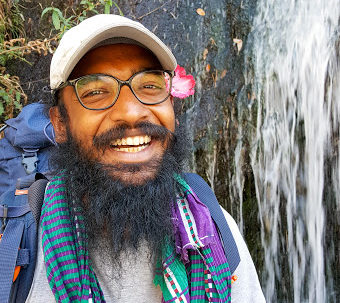
Siddharth Agarwal
An environmentalist, Siddharth Agarwal is walking along Indian rivers for the last four years, recording the stories, myths, rumours, fears and rituals of the people dwelling alongside them. Now his journey of six-months along the Ganga is being released in the form of a documentary film titled Moving Upstream: Ganga, a testament to his journey along the river.
An aerospace engineer from an IIT, Siddharth decided to walk along the rivers leaving behind his life in the urban jungle. While talking to the Patriot, Siddharth reveals that his sole motive in leaving his urban life and walking along the rivers was to document the lives of the people who call the banks of these rivers their home. “When I was in college, I was already cycling with a friend. We traveled from Kolkata to Mumbai in 2014. But I told my friend Ujjawal, who was cycling along with me, that the cycle is still a fast medium. What if we start walking? And so my journey started. I first walked in Rajasthan, then along the Ganga” Agarwal revealed.
Well aware that his attire might make people conscious, Siddhartha says walking helped him connect with people and make them open up to him.“Since I was walking, I had enough time to make people comfortable. And I never brought out my camera until the person whom I am talking to is comfortable.”
“Walking breaks stereotypes and makes us conscious about our casteist language, slurs that we use, because you never know who the person is on your way, you are talking with”. Along the way he interacted with people from different communities from the lower castes and learnt how unintentionally castestist slurs often permeate into normal language and can be unearthed when people pass casual comments on someone’s look. “A Farmer Prem Singh, explained this phenomenon, we use Ganvar to denote uneducated but it means a person living in a village. And Nagrik, the Hindi counterpart of the word citizen has literal meaning, a person living in Nagar (City).”
Interestingly enough, Siddharth was walking at a time, when the world was suffering from infodemic, misinformation and rumours triggering mob violence. For example, one of the common fears spurred on by rumours was that of child theft that in the past couple of years has led to many cases of mob lynching across India. Aware of these rumours, Siddharth, a person with long beard, dark complexion — fits the descriptions that invokes the ire of the misinformed — kept walking.
Even though he knew that it was not going to be easy, the rumours and misinformation did not deter him. “Overall anger has increased among people. So fear was there.” After Pulwama, an incident happened in Bihar arousing suspicion in the people.“But since, I am continuously walking and talking, and unlike cities people in villages are more connected, it helped me establish connections,” he says.
On his journey, Siddharth explored socio-cultural dynamics around the Ganga. Talking about it, he says, “Unfortunately, the culture along the Ganga has homogenised, there are not many indigeneous communities left, just fishing communities. And their stories, myths are mixed with Hindu mythologies.”
When he was traveling along Ken and Betwa rivers, he found that a lot of people don’t even know about the Ken-Betwa river linking project, especially those who do not live on the river floodplain. The few who knew about it, had very little knowledge — limited to government press releases. “When I told them that the project is about linking both rivers, I didn’t have to explain much, because farmers’ know how water flows. So they realised that it would affect them,” he adds.
In February 2019, Agarwal joined hands with journalist Paul Salopek. Salopek is touring the world on foot, and is behind the growing popularity of slow journalism. His company brought Siddharth’s work to a global audience. And his organisation Veditum, started a walking fellowship that allowed people to embark on their journeys along similar lines. So far they have funded 8 people under this fellowship and are planning on funding many more.
Siddharth hails from a middle class family in Kolkata, and choosing activism after studying from IIT, was not the career that his family had thought of. “I was stubborn since childhood, though it was unconventional for an orthodox marwari family to choose activism, but fortunately my family is accommodative and understanding.”
Siddharth identifies himself as an activist along with a researcher, and a photographer. Explaining his activism, he said that his values determine whatever he does, “As long as my values are not compromised, I believe my activism and whatever I do is on the right track.” And he wants to continue his way of activism, “by walking”.
Veer Ahlawat’s final-round 67 sealed a three-shot win at the Rs 1 crore CIDCO Open…
OnePlus has launched the 15R smartphone and Pad Go 2 tablet in India, with prices…
Nearly 2,800 Delhi vehicles denied fuel on first day of 'No PUC, No Fuel' drive…
Delhi Police arrested five men in two fake investment scams, unearthing a Rs 24 crore…
The ED seized cash, silver and gold worth over Rs 19 crore in fresh raids…
Boho Bazaar’s Christmas edition returns to Delhi on December 20–21 with 300+ brands, live music…